Hurt and disappointment for the Netherlands as they were denied their first-ever FIFA Women’s World Cup title after losing 2-0 to an extraordinary USA side.
The USA successfully defended their FIFA Women’s World Cup title after defeating first-time finalists the Netherlands thanks goals from Megan Rapinoe and Rose Lavelle. Prior to the game, there were some worries that these two players might miss out on the final due to injuries. But both were deemed fit enough to play and started against De Oranje Leeuwinnen. Ultimately, these two became the heroes of the USA after scoring the winning goals via a coolly-taken penalty and a magnificent goal following a solo run.
Both goals were scored in the second half, but the USA have been dominating the game since the start of the game. Both teams may be level in terms of player quality. However, tactically, everybody that watched the game knows which one’s superior.
Now let’s get a closer look at how both teams fare against each other in this tactical analysis.
Lineups
USA (4-3-3)
Starting XI: Naeher – O’Hara, Dahlkemper, Sauerbrunn, Dunn – Lavelle, Ertz, Mewis – Heath, Morgan, Rapinoe
Bench: Lloyd, Press, McDonald, Franch, Long, Harris, Sonnett, Davidson, Krieger, Horan, Brian, Pugh
Coach: Jill Ellis
Netherlands (4-2-3-1)
Starting XI: van Veenendaal – van Lunteren, Dekker, van der Gragt, Bloodworth – Groenen, Spitse – van de Donk, Miedema, Martens – Beerensteyn
Bench: Geurts, van der Most, Roord, Kerkdijk, Jansen, Kop, Kaagman, Jansen, Pelova, van de Sanden, van Es, van Dongen
Coach: Sarina Wiegman
Both team’s setup – tactical analysis
USA
Ellis deployed her team in the usual 4-3-3 system in this match. The USWNT coach has used the very same system throughout the entire competition, albeit a little tactical tweak in every match.
There were only two changes in the starting lineup. Sam Mewis started in the left centre-mid spot ahead of Lindsey Horan in the game. Meanwhile, Christen Press was back on the bench while USA captain Rapinoe saw her name once again in the starting 11.
Ellis seemed to employ the 4-3-3 system until midway through the second half when she decided to play a five-man defensive system. In this system, Julie Ertz seemed to drop deeper into the centre-back spot, playing between Abby Dahlkemper and Becky Sauerbrunn. They formed a 5-4-1 shape in defence, which could turn into a 5-2-3 in attack.
Netherlands
Sarina Wiegman made a considerable amount of changes in the game against USA and we’re not only talking about the starting lineup. Perhaps after using very similar tactics throughout the competition, Wiegman was worried that the USA might be able to read their game and easily anticipate their tactical plays. She seemed to try to surprise Ellis and her side in the final. Unluckily, their game plan didn’t work out and the USA unsurprisingly dominated the game since the first half.
Wiegman fielded her team in a 4-2-3-1 system. Now there were some questions that need to be asked when we look at her team’s setup.
Firstly, Wiegman chose not to play both Merel van Dongen and Kika van Es – starting Dominique Bloodworth in the left-back berth instead. Experienced centre-back Anouk Dekker and Stefanie van der Gragt paired up in the heart of the defence.
Secondly, attacking midfielder Danielle van de Donk was moved to play on the right-wing. Right-winger Lineth Beerensteyn played as the centre-forward in this game, while Dutch top scorer Vivianne Miedema moved deeper to play behind the former in the attacking midfield spot.
Late in the second half, Wiegman took off Dekker for Shanice van de Sanden – therefore shifting the shape of her team into a 3-4-3 (3-3-1-3). It still didn’t work well both offensively and defensively – in fact, it might have made it worse for her team.
We will delve deeper to analyse Wiegman’s tactical decisions in this match in this tactical analysis.
Netherlands got a taste of their own medicine
The USA started the game with attacking intent, they moved the ball around quickly, trying to get forward. Their intention was to take the lead early in the game which would put them in an advantageous position. They exchanged quick one-two touch passes every time, rarely wasting time with the ball. They were also extremely quick on the break after recovering possession.
Ellis’ side usually built their play out from the back, but they play a very quick, very straightforward passing play – preferring to move the ball vertically. They’d usually try to play medium-long range diagonal passes. With the Netherlands allowing themselves to freely play the ball at the back, the USA pushed their defenders high, putting pressure to the Netherlands and pinning them inside their own half, even when they’re (USA) not in a defensive stance.
This, of course, posed some risk to USA themselves, knowing that their opponents were very quick in breakaways. But the USWNT managed to anticipate the Dutch counter-attacks by destroying the root of the problem. Immediately after losing possession, the USA would counter-press and swarm the ball-carrier. This is something that I’ve mentioned numerous times in the previous tactical analysis regarding the Netherlands – that they are struggling against teams who block high and press aggressively – and especially the ones who counter-press. The two centre-backs + Sherida Spitse are the backbones of the Netherlands’ buildup. If you mark them tightly, press them aggressively – the Dutch will have a very, very difficult time in the game.
To make matters worse, the two centre-backs, Dekker and van der Gragt are not as proficient in playing the ball as Bloodworth. They were unable to handle the pressure given by the USA, often panicking and losing possession once again in their own half via inaccurate passes and failed clearances.
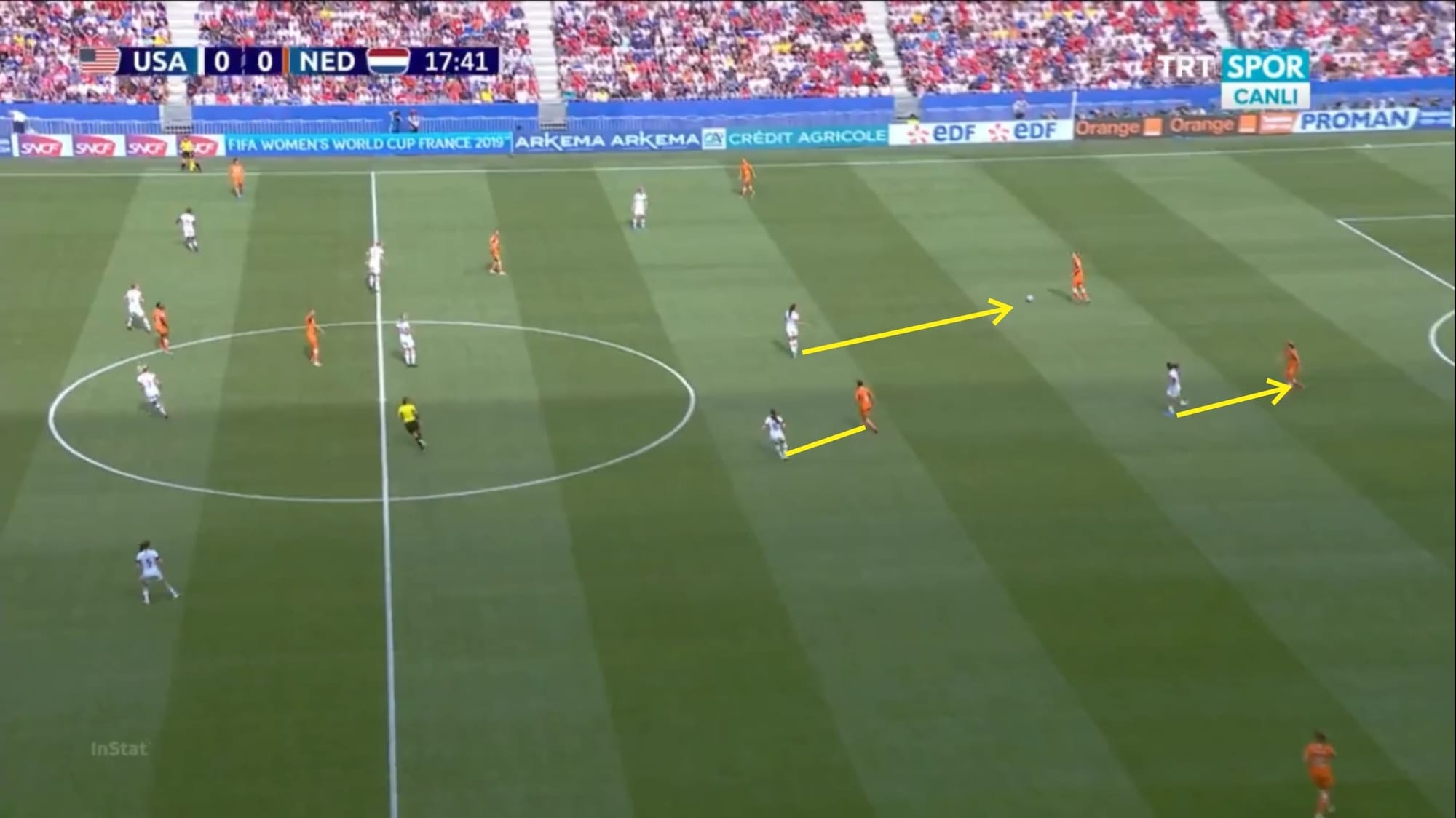
Bloodworth, on the other hand, was played on the left side of the defence. She didn’t seem to be able to distribute the ball well due to the tight space provided to her. Bloodworth, despite being a rather decent dribbler, also seemed to concede possession numerous times in the game. Most of the time, she’d attempt to dribble the ball inwards so that she could make a pass with her favoured right foot. A lot of time, that ended in failure as both Lavelle and Tobin Heath would immediately swarm her, win the ball back and launch a counter on her side of the defence.
The USA tried to exploit spaces out wide, forming a 2-3-5 shape in attack.
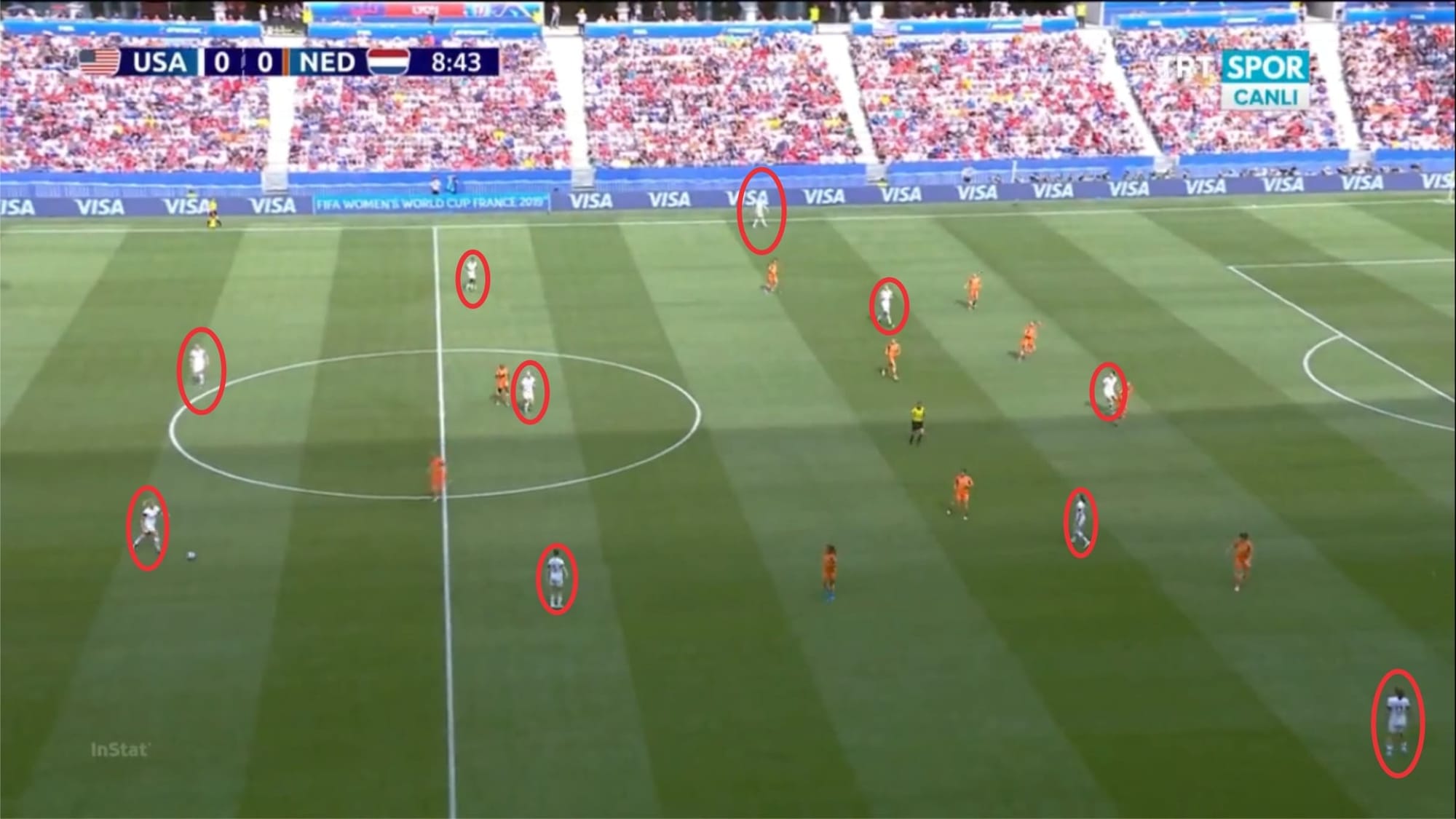
Take a look at how they stretched out Netherlands’ defence. Rapinoe and Heath both stayed wide with Lavelle and Mewis occupying the half-space. They have also effectively outnumbered the defenders by making a 5v4 situation. Not just that, the USA also seemed to play diagonal long passes in this game – from the centre to the flanks, from the flanks to the centre, and from one flank to another. They’d try to drive the Dutch to one side of the pitch, then launch the ball to the other side. The USA really took advantage of the space given to them in this game and they’re loving it.
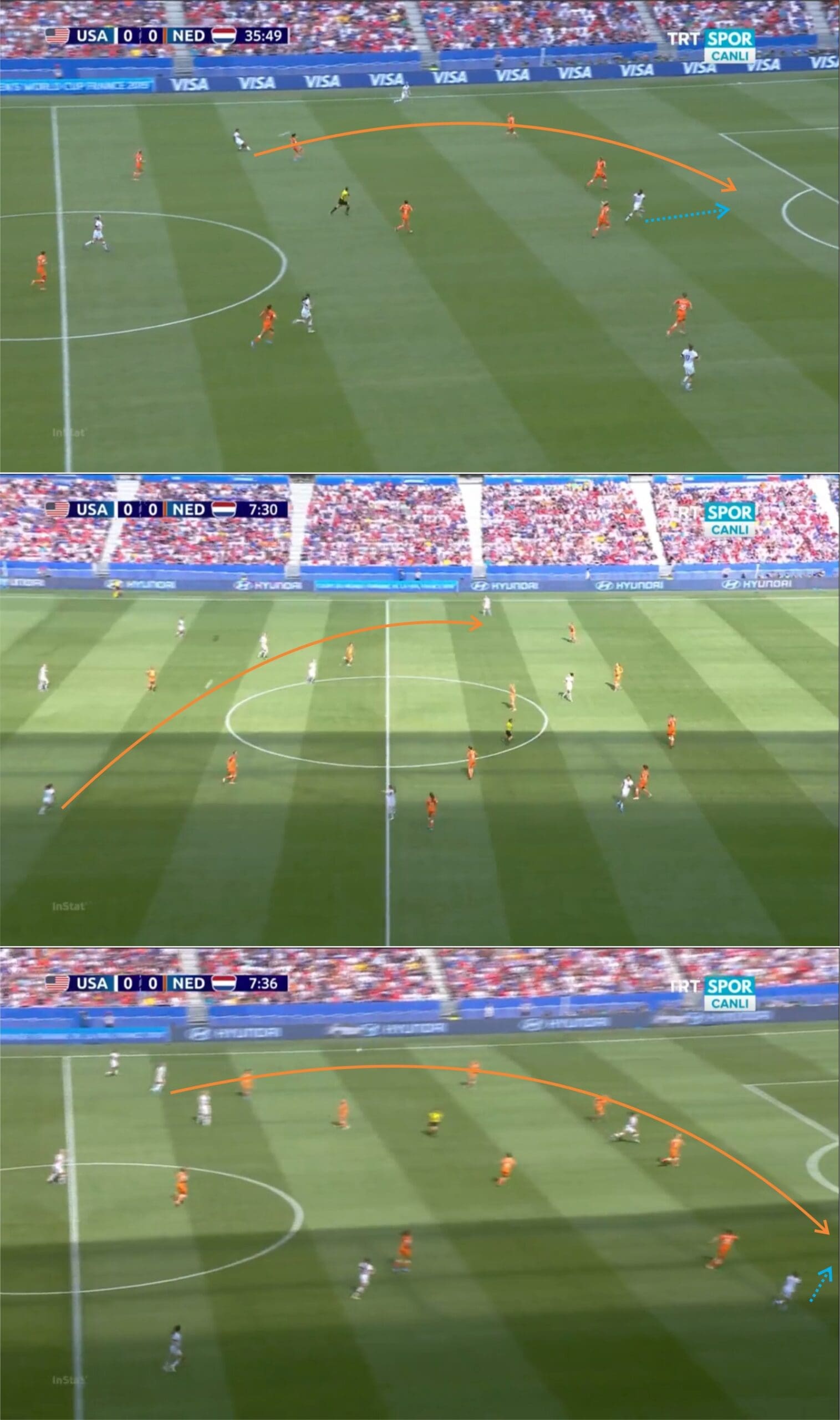
These tactics were very similar to the Netherlands’ playing style throughout the competition – usually with van de Sanden and Lieke Martens stretching wide while Jackie Groenen and van de Donk occupied the half-space. The Netherlands also tended to play with diagonal long balls throughout the competition. Strangely though, none of the tactics that I just mentioned right now was used by the Dutch in this very game. Yet they had to have a taste of their own medicine. We’ll discuss their attacking approach later in this tactical analysis.
With the Netherlands granting freedom for the USA on the flanks, the latter thanked the former by delivering pinpoint crosses into the box – most of which were very troublesome, even almost converted into a goal were it not for Sari van Veenendaal’s heroics.
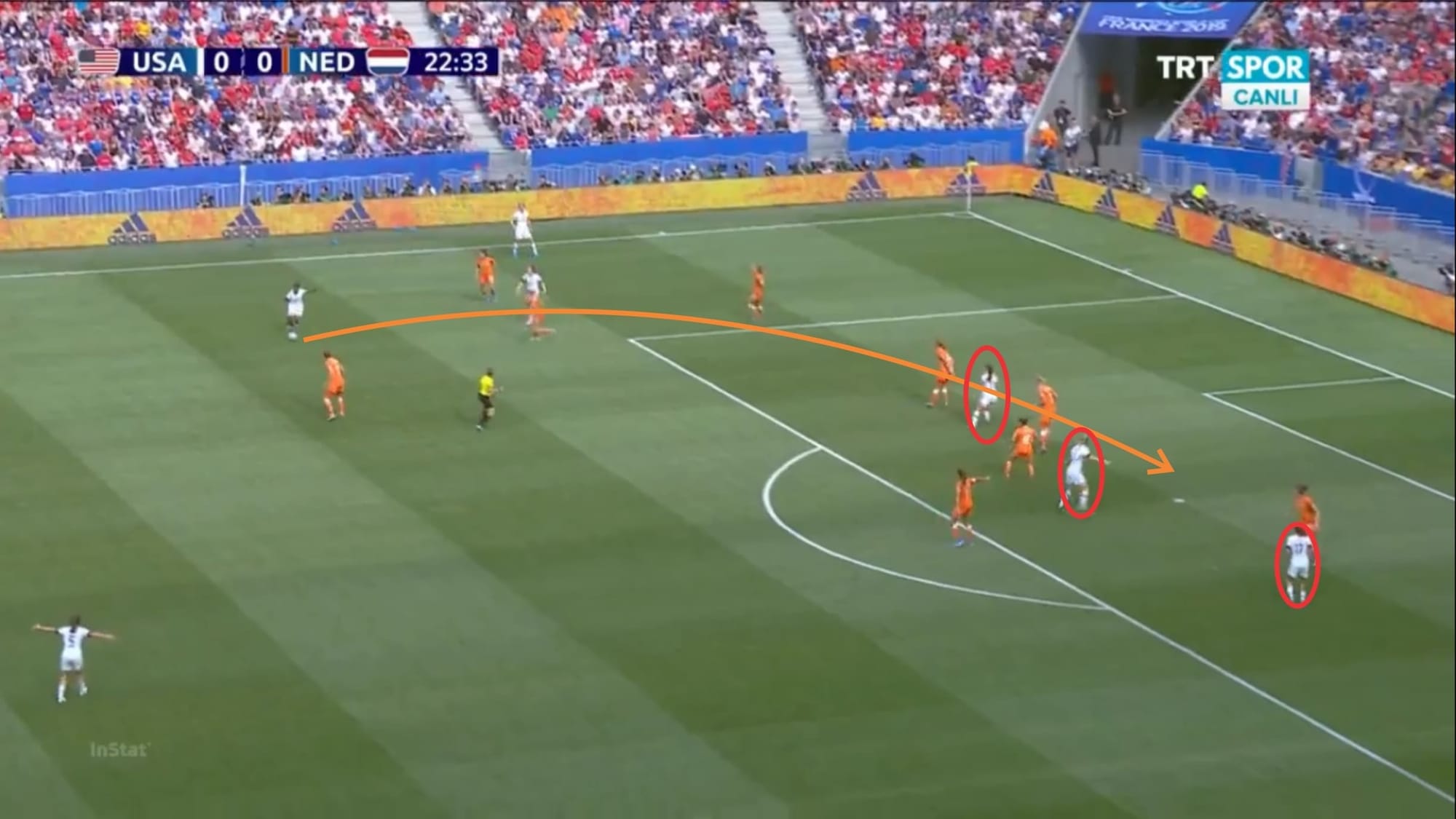
Ellis’ side tend to put a number of players inside the box to attack the cross. As we can see from the picture, Heath and Mewis also seemed to enter the box. The latter usually arrived later, causing some sort of surprise to the Dutch defence. This was proven as she managed to meet the cross numerous times inside the box, unmarked.
The USA also tried to play through the middle occasionally. The USA’s attackers positioned themselves in between the Dutch midfielders, therefore providing passing options in pockets of space in the middle.
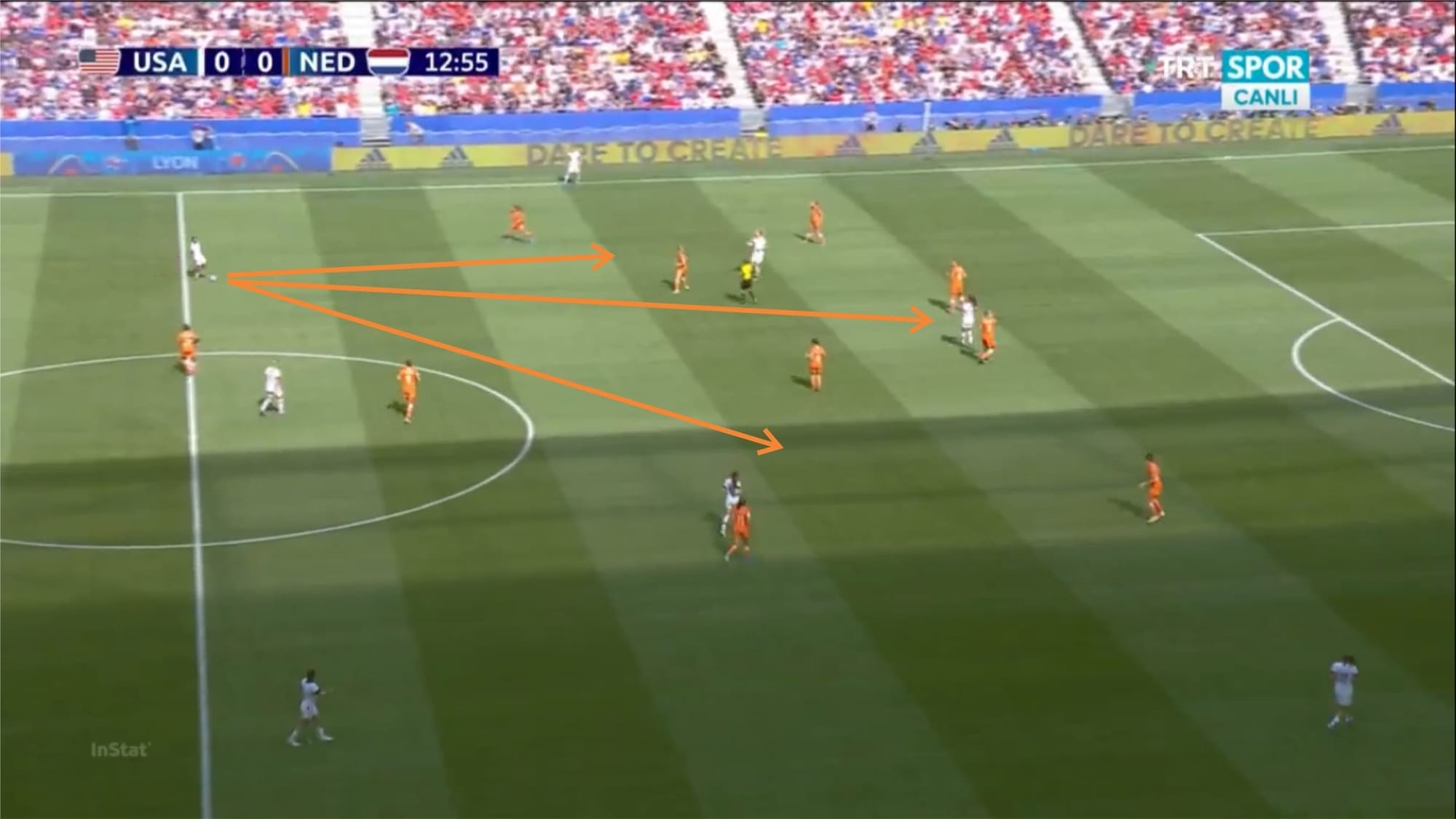
Far too deep
The Netherlands’ game was mostly about containment in this match. They defended deep. In fact, far too deep that even after regaining possession, their main job was to not lose the ball again to the opposing team’s pressure before they could even start their attack.
The Netherlands, meanwhile, defended in a 4-4-1-1 shape as shown clearly in the picture below.
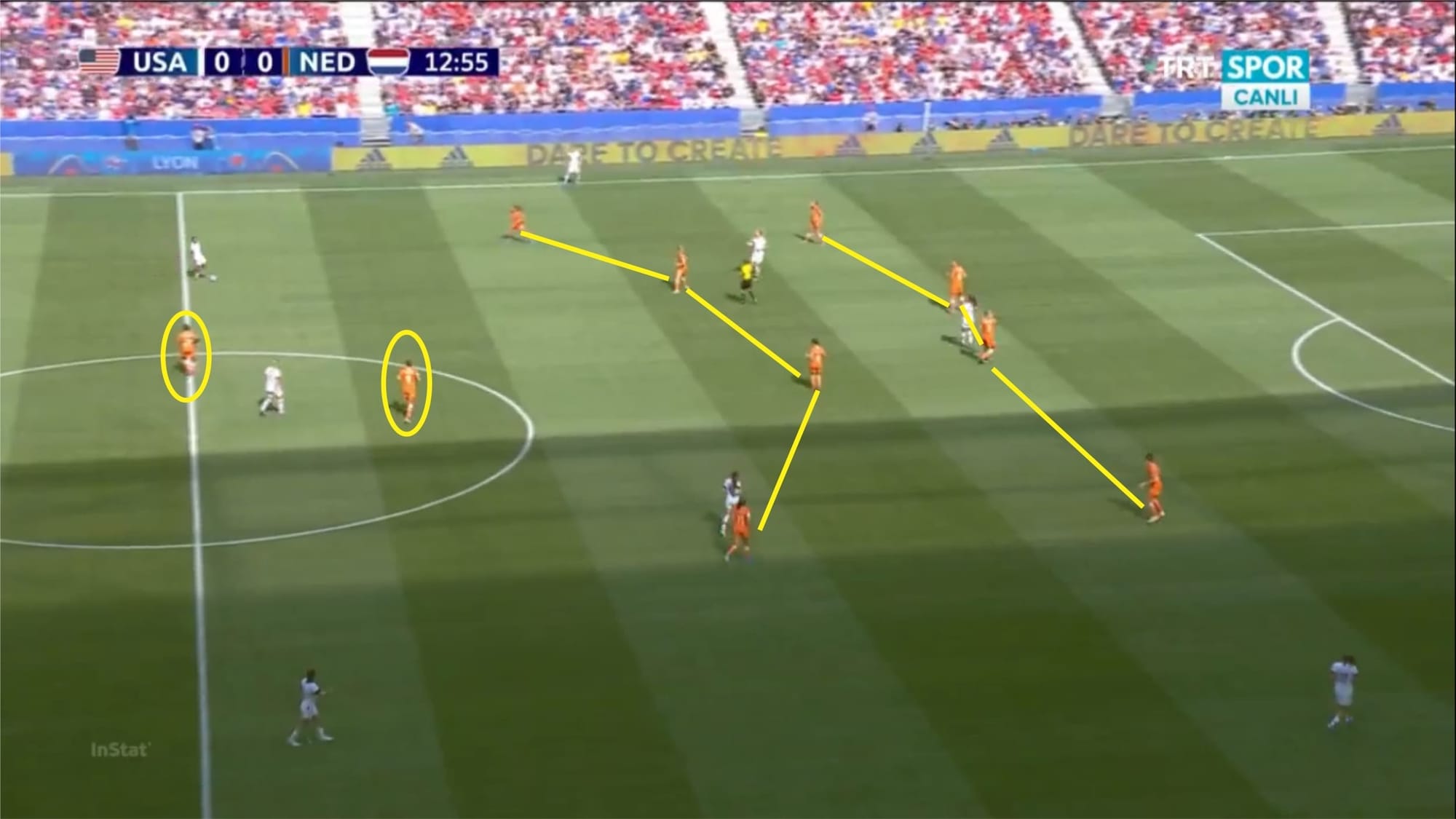
The Netherlands defended in a compact low block. They seemed to maintain a fairly narrow shape as they preferred to contain central areas. The USA, as mentioned earlier, capitalised on this defensive approach with their wingers really wide. USA’s backline also didn’t receive much pressure from the Netherlands, allowing them to play progressive passes into dangerous areas – usually to the wingers who profited from the lack of marking in wider areas.
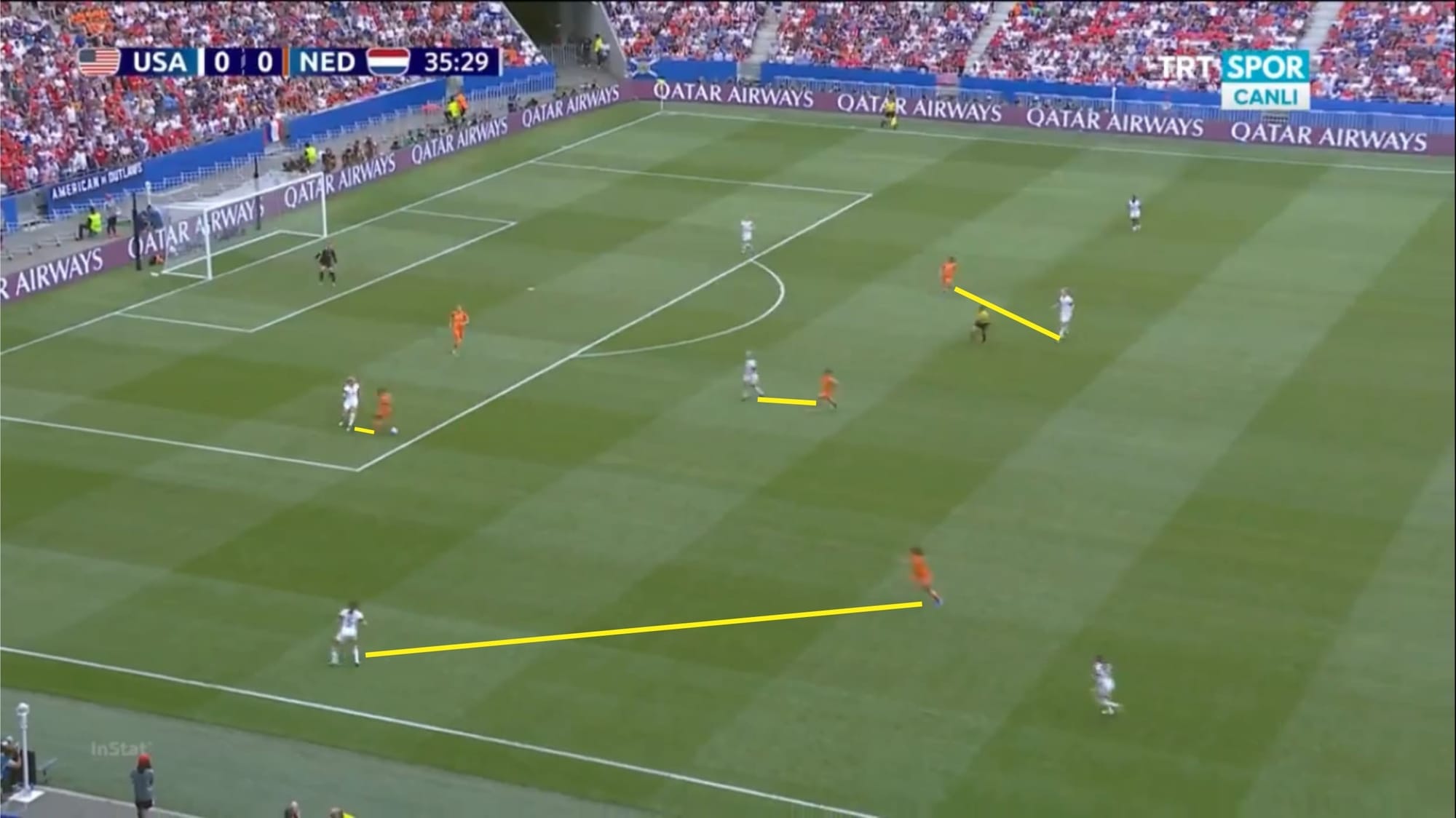
The Netherlands tended to only press when the ball’s inside their own half. There were only very rare circumstances where the Netherlands decided to push high and press the USA’s backline in the first half. In the picture above, Miedema pressed the USA in their half after a rather awkward pass to goalkeeper Alyssa Naeher. This prompted the other Dutch players to push forward and press as a unit. This was a big problem for the USA as they eventually lost the ball deep in their own half. Unfortunately, no other Dutch players advanced forward to support the team after winning the ball. They only regained possession briefly before being swarmed and outnumbered again, losing possession once again.
Wiegman should have seen the potential of high blocking and high pressing against the USA. Her team looked comfortable pressing high up the pitch against Sweden and at times they managed to force the USA into making mistakes with via aggressive press. Yet she decided that it would be better to contain their own half and absorb the USA’s attacks. Of course, blocking high would leave the backline vulnerable, especially against USA’s forwards, who are known to possess explosive pace. But surely they can be kept quiet if the Netherlands managed to properly mark them and cut the distribution system from the back.
Perhaps the only positive side of the defence of the Netherlands that I could see was that they managed to keep Alex Morgan quiet for most of the game. Both Dekker and van der Gragt was tasked to mark her tightly in this game, limiting her to only one or two touches of the ball.
Netherlands’ plans to attack fail to unfold
Aside from their confusing approach to defending, the Netherlands also seemed to play in a rather unusual way in attack.
Let’s start this out with the fact that main striker, the goal-getter Miedema, was played deeper. She was played behind Beerensteyn who usually plays on the wings. Meanwhile, van de Donk, the main link between the defence, midfield, and attack, the player who often dropped into pockets of space in between the opposing midfielders, and the attacking midfielder who usually occupies the half-space between Martens and Miedema – was played in the right-wing spot. I’m not sure what Wiegman was trying to pull off here, but it surely didn’t work out in this game.
One of the many things that seemed to be changed in the Netherlands’ attacking play was the lack of diagonal long passes. In this game, the Netherlands seemed to attempt to advance through a tougher route through the middle.
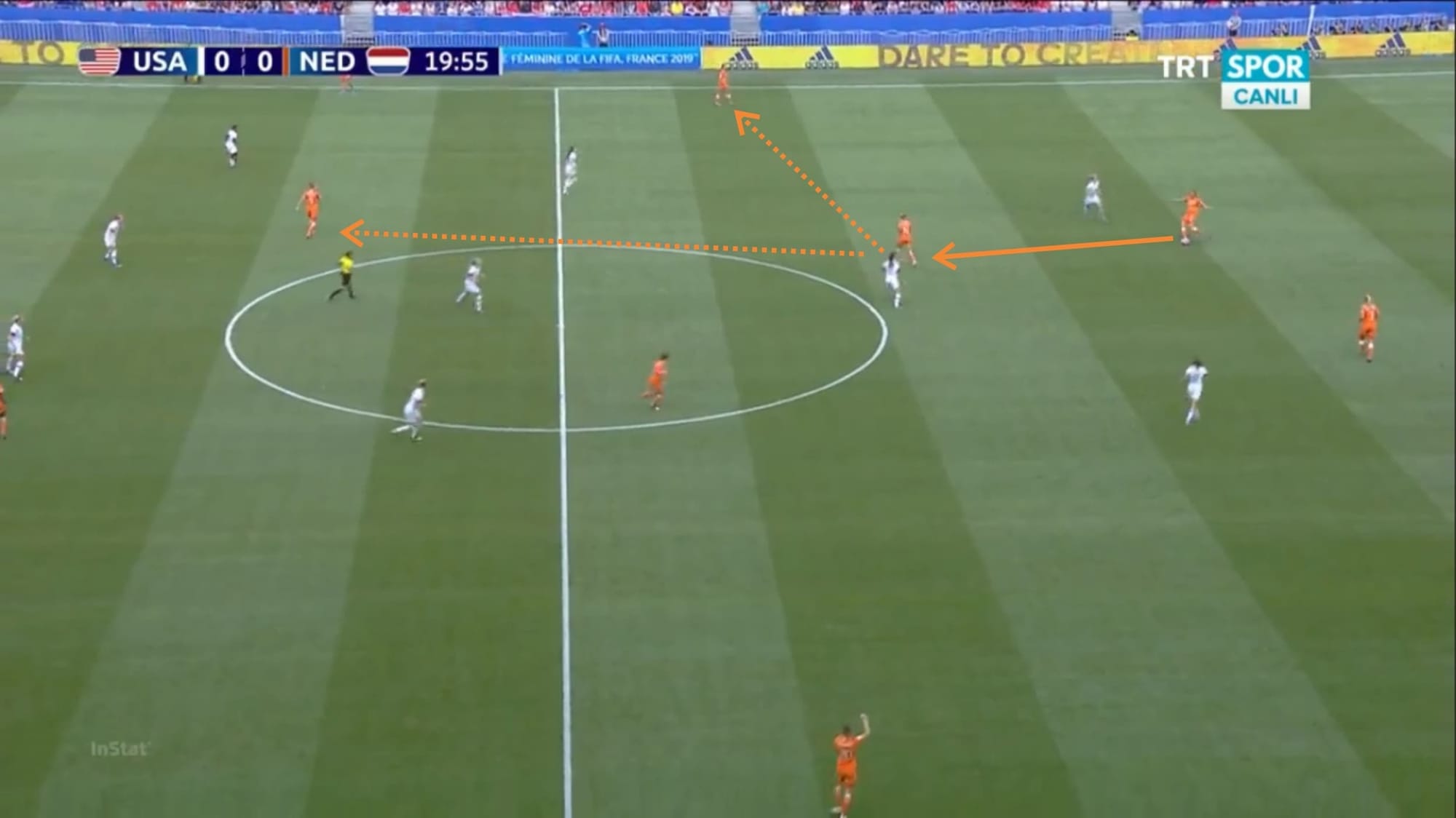
As we can see in the picture above, double pivot Groenen and Spitse dropped deeper to get the ball from either centre-back. Both centre-backs as we can see are also under intense pressure. In this situation, van der Gragt chose to play the ball to Groenen who had several options to pass the ball to. The latter, of course, had to move the ball quickly as well, knowing that she’d only have at most one or two touches before getting swarmed by the USWNT. Groenen had the options to play the ball to Miedema or pass it wide to Desiree van Lunteren.
The Netherlands mostly played like this, exchanging short, quick passes. They rarely played long balls into space. And most importantly, the centre-backs didn’t seem confident enough to play the diagonal long passes.
But here’s another thing that they seemed to fail to execute in this game. Their usual attacking routine that looks like this picture below.
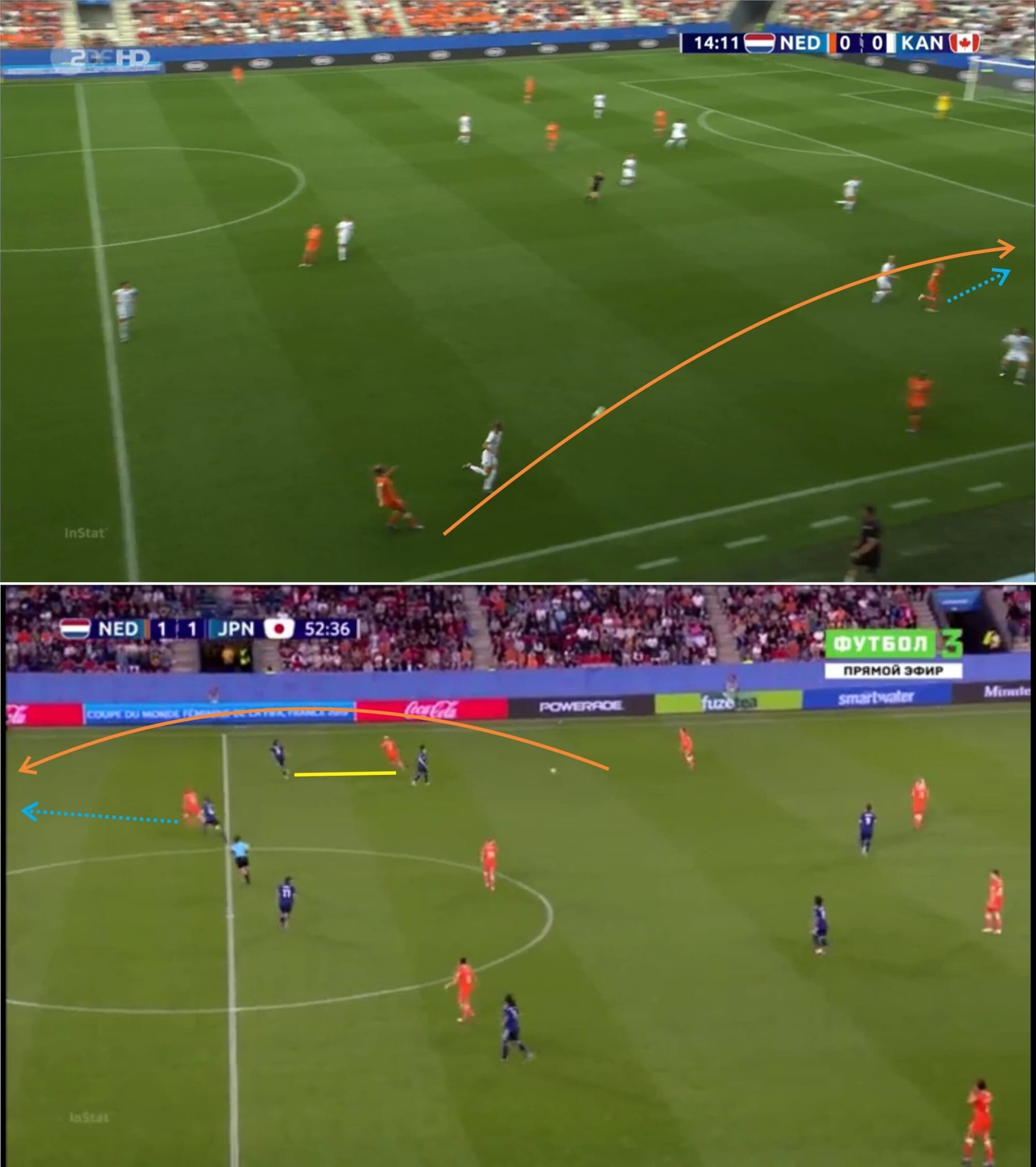
In the pictures above, the winger drops deep, attracting the opposing full-back out of position. This usually triggers Groenen to exploit the space left out wide as she made the run from the half-space. There are perhaps two situations that may trigger this routine. A pass from the centre-back to the full-back or a pass to the winger, who then gives the ball back to the full-back. Now let’s see what really happened in the game against the USA.
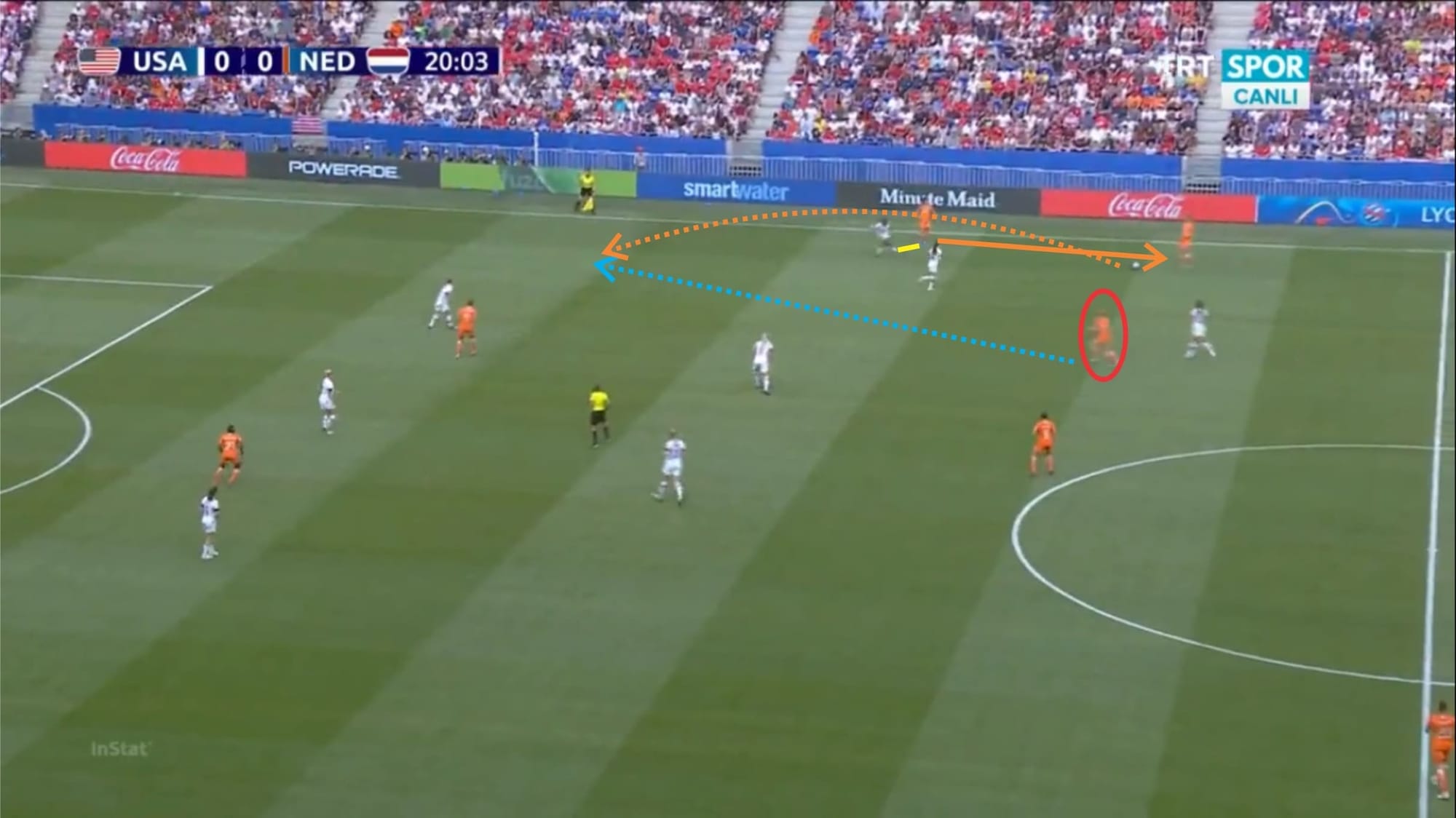
In this situation, Groenen, who played as a defensive midfielder, managed to escape the pressure of USA in the middle of the field before passing the ball towards van de Donk. The latter brought the ball deeper while dragging Crystal Dunn out of position. She then passed the ball towards van Lunteren so that the right-back could launch it forward into space. Groenen though had to start her run from deep, rendering her unable to reach the designated spot to exploit the space on time.
This, of course, also happened on the left flank where Martens was playing. We can see right-back Kelley O’Hara following Martens, drifting rather far from her position. The problem was nobody seemed to take advantage of the space. Not even Miedema, who chose to stay central.
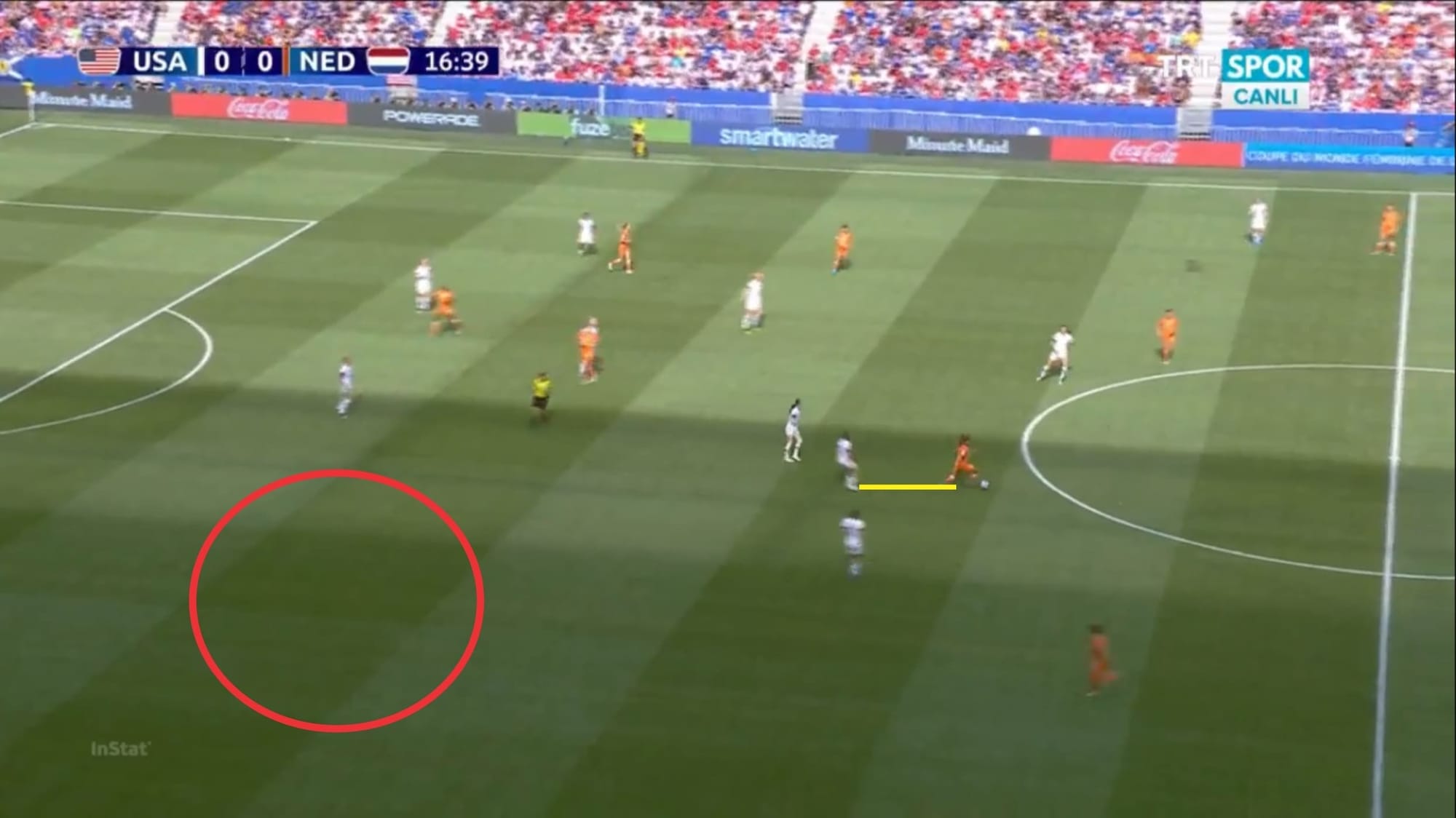
If only the Netherlands managed to pull this move off, they might have caught the opposing team off guard and caused them some serious problem.
Now let’s take a look at the USA’s defensive shape. They seemed to maintain a 4-3-3 shape in defence. They maintained a rather narrow shape in the middle of the field and upfront, allowing the Netherlands to exploit the space there.
However, the USA kept a wide defensive line, not allowing the Dutch any chance to attack the flanks through their wingers. We can see that from the picture below.
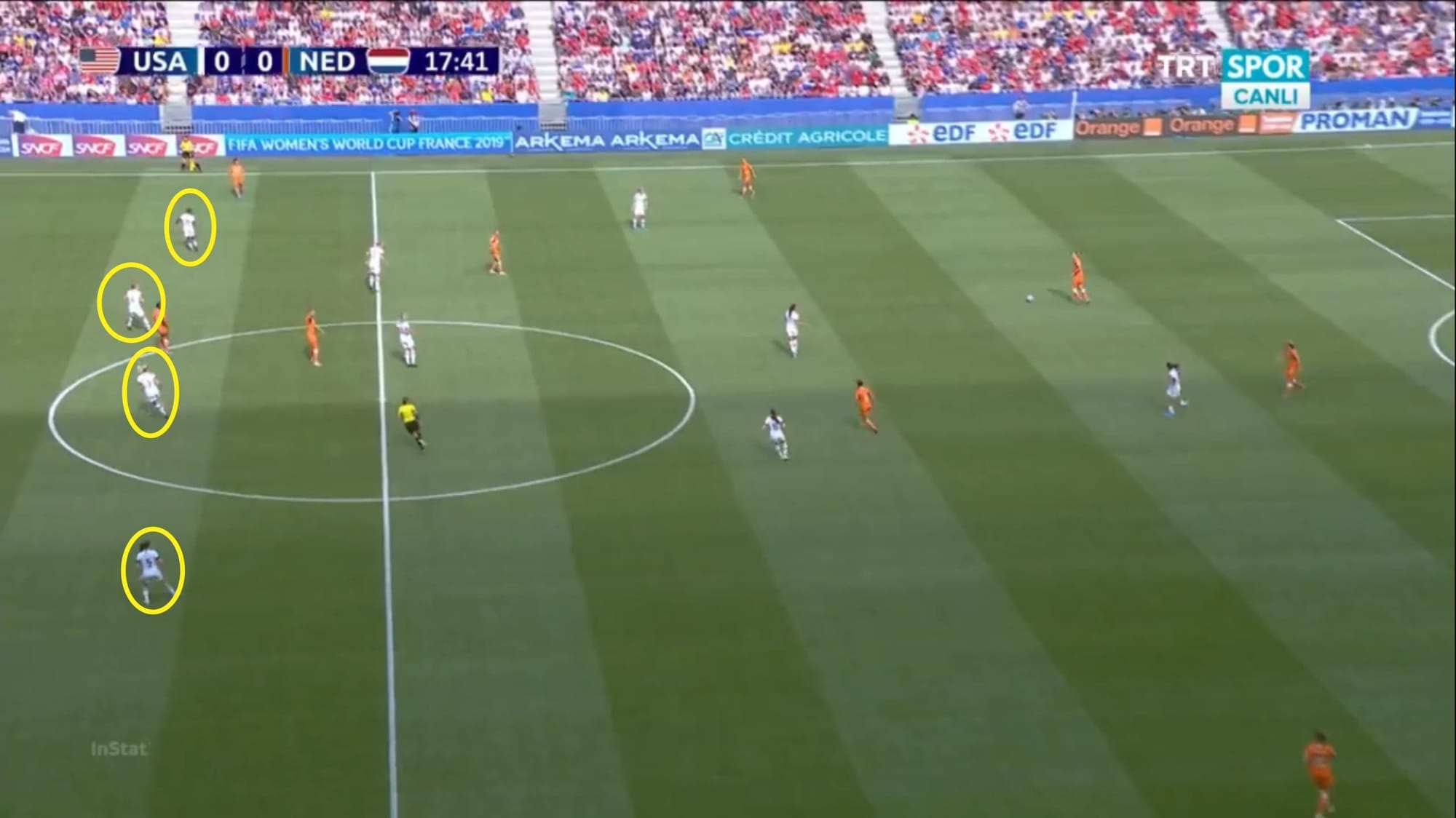
The Netherlands did attempt several long balls in this game. However, despite usually being the superior side when it comes to aerial duels – against the USA, the Netherlands struggled quite hard to win any aerial challenges. Especially in the opposition half. The Netherlands often failed to win both the first ball and second ball, effectively giving the possession away after the pass.
In attack, the Netherlands seemed to shift into a 2-4-4 shape. They seemed to employ the same tactics as in the Sweden game. A bit different than what they usually used in the five previous games though, where they took a 2-3-5 shape in attack. This might be affected by their starting shape which was 4-2-3-1. With the 2-4-4 shape, the Netherlands had more stability and felt more secure when playing in the middle of the field due to the presence of double pivot Groenen and Spitse. However, in this shape, they missed the chance to capitalise on wider areas as they usually do as well as outnumbering the opposing backline.
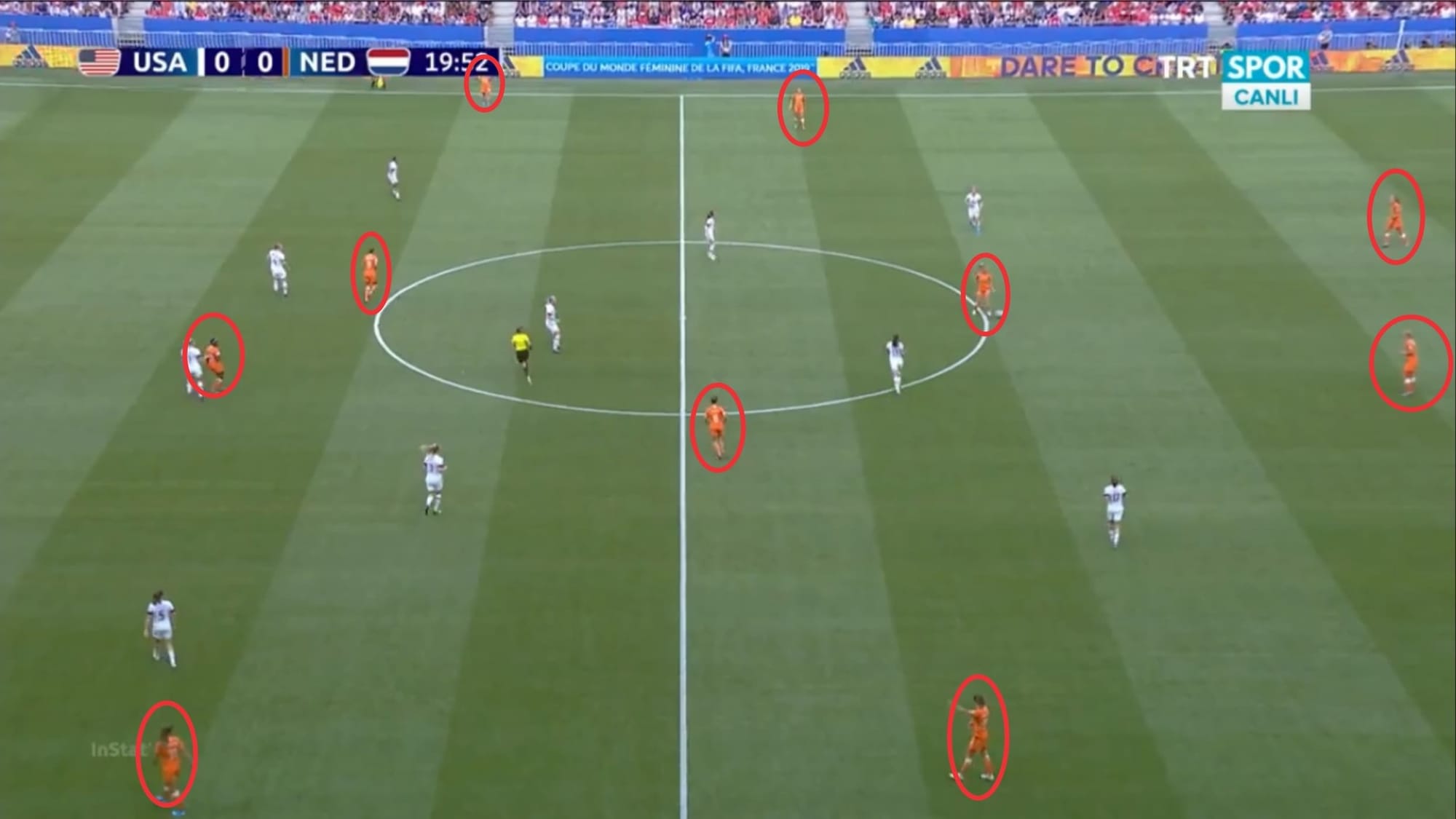
If you’ve watched the Netherlands play in this year’s FIFA Women’s World Cup, of course, you’d notice that their most dangerous attacks have come from quick breakaways. Utilising the speed of both wingers. We can see that in this picture below.
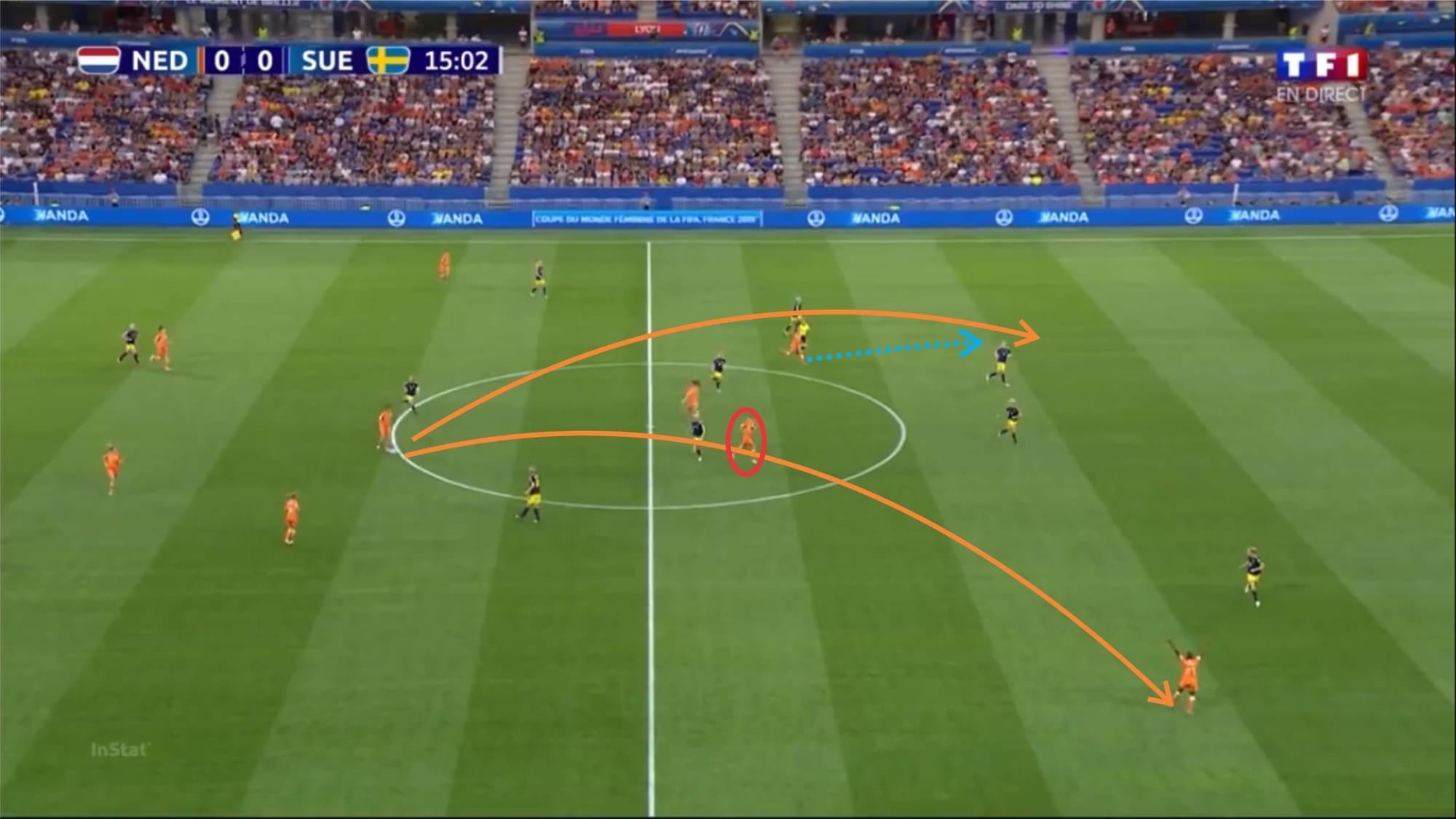
In this picture, we can see that after a turnover in possession, the Netherlands always looked to break forward quickly through the wingers. Both wingers sat rather high and were always ready to make the run after the recovery of possession. While one winger made an inside run, the other drifted wider to stretch the defence and open up space. Miedema meanwhile, stalled her run to eventually arrive late in the box.
It didn’t happen quite like this in their game against the USA and we’ll take a closer look at that in the pictures below.
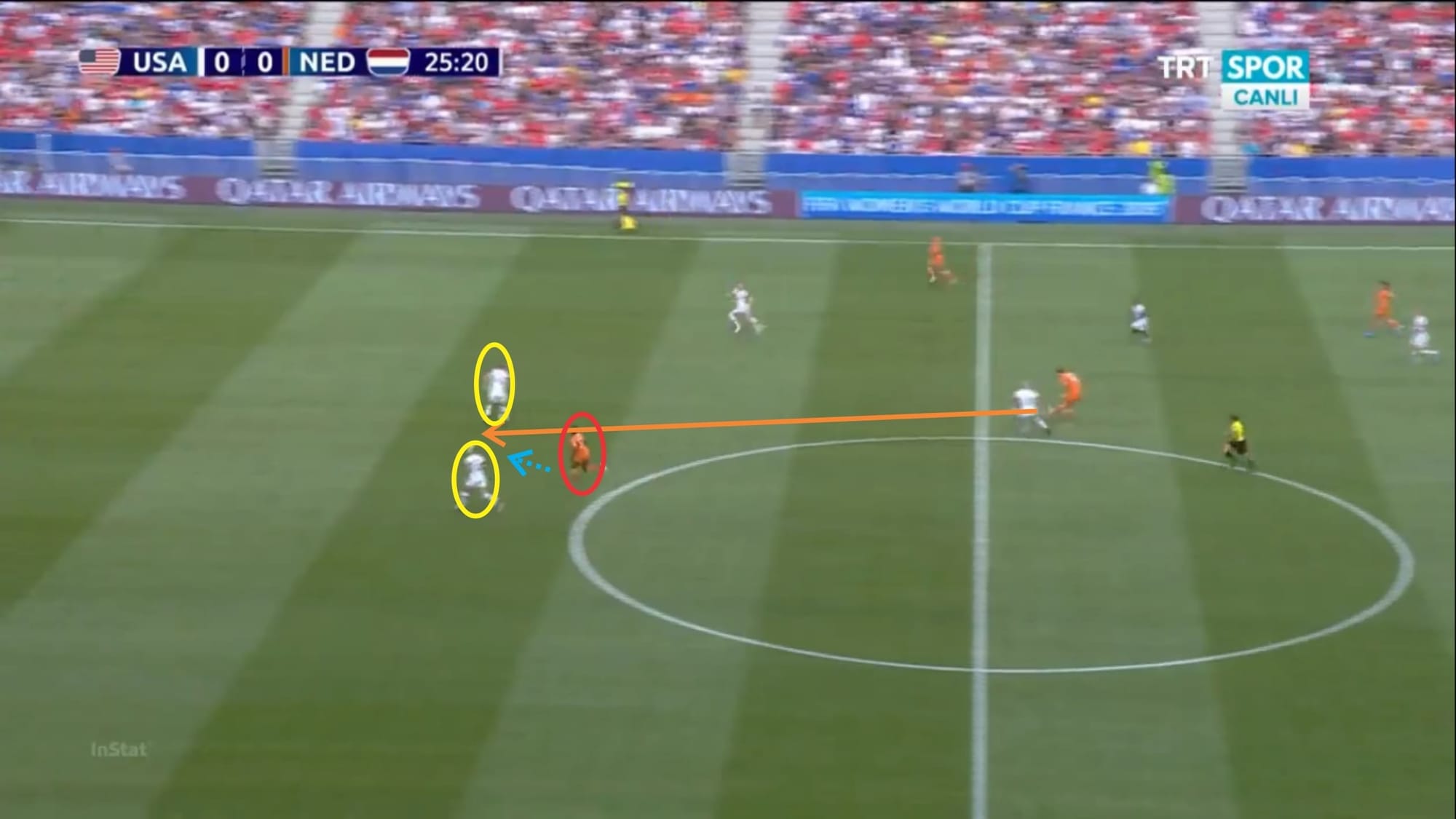
Due to their deep block, the Netherlands had to sit further away from the opposing goal, thus covering longer distance when launching a counter.
In this picture, we can see Beerensteyn already in her stride on the counter while Miedema was with the ball. The latter passed it through towards Beerensteyn who outpaced the two USA centre-backs, but Naeher managed to rush off her line with perfect timing to clear the ball away. You can already spot the difference in this picture from the previous one. In here, Wiegman made Beerensteyn – the centre-forward – as the counter target, not the wingers. The wingers, meanwhile, were trailing, they sat much deeper in their own half than they usually did which means that they’re not going to be the main target on the counter.
It could be understood, of course, as an attempt to exploit spaces behind the USA’s high defence utilising Beerensteyn’s blistering pace, but this often didn’t work out well. Firstly, Beerensteyn was marked by two centre-backs at the same time. Breaking through centrally might be almost impossible. As a result, Beerensteyn often roamed wide to open up space as she prepared to receive the ball on the counter.
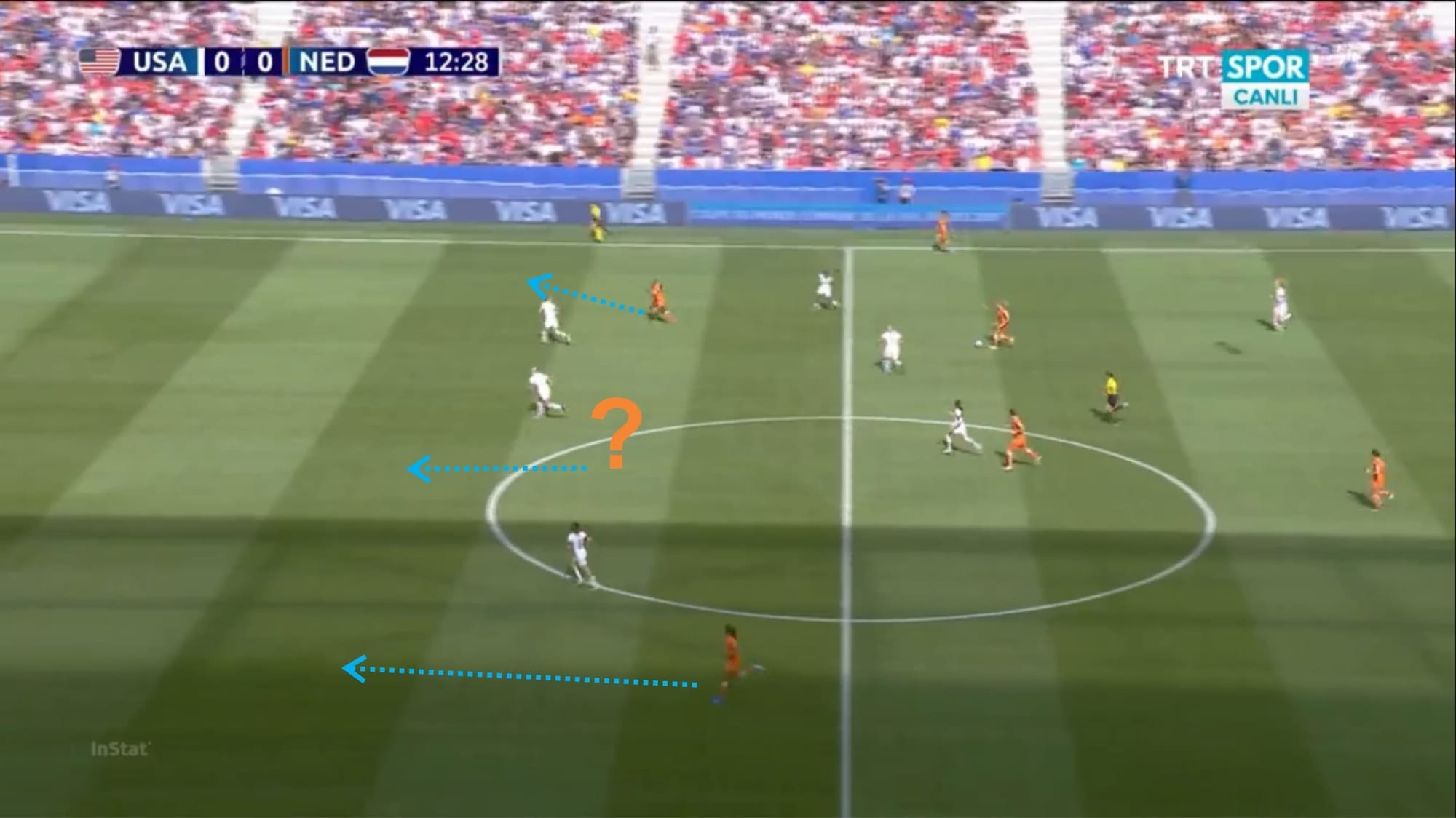
But as we can see in the picture above, Beerensteyn did manage to lose her marker by roaming wide. Miedema once again with the ball. The latter passed it through towards Beerensteyn out wide.
The pacey forward then brought it forward, but she didn’t know what to do next. There was no player in the middle. If she brought the ball into the byline and delivered a cross, there’s not going to be any player to meet it inside the box (except for Martens. Meanwhile, there’s a huge chance that she’ll lose possession before executing a meaningful attacking action if she decided to cut inside and drive into the box. Beerensteyn tended to avoid using her weaker foot anyway, so it’s a bit unlikely to see her cut inside from the right. If she decided to hold up the play, there will be no more counter-attack. The USA players would be back to defend in no time and she’ll find herself under intense pressure before she could find support from her teammates.
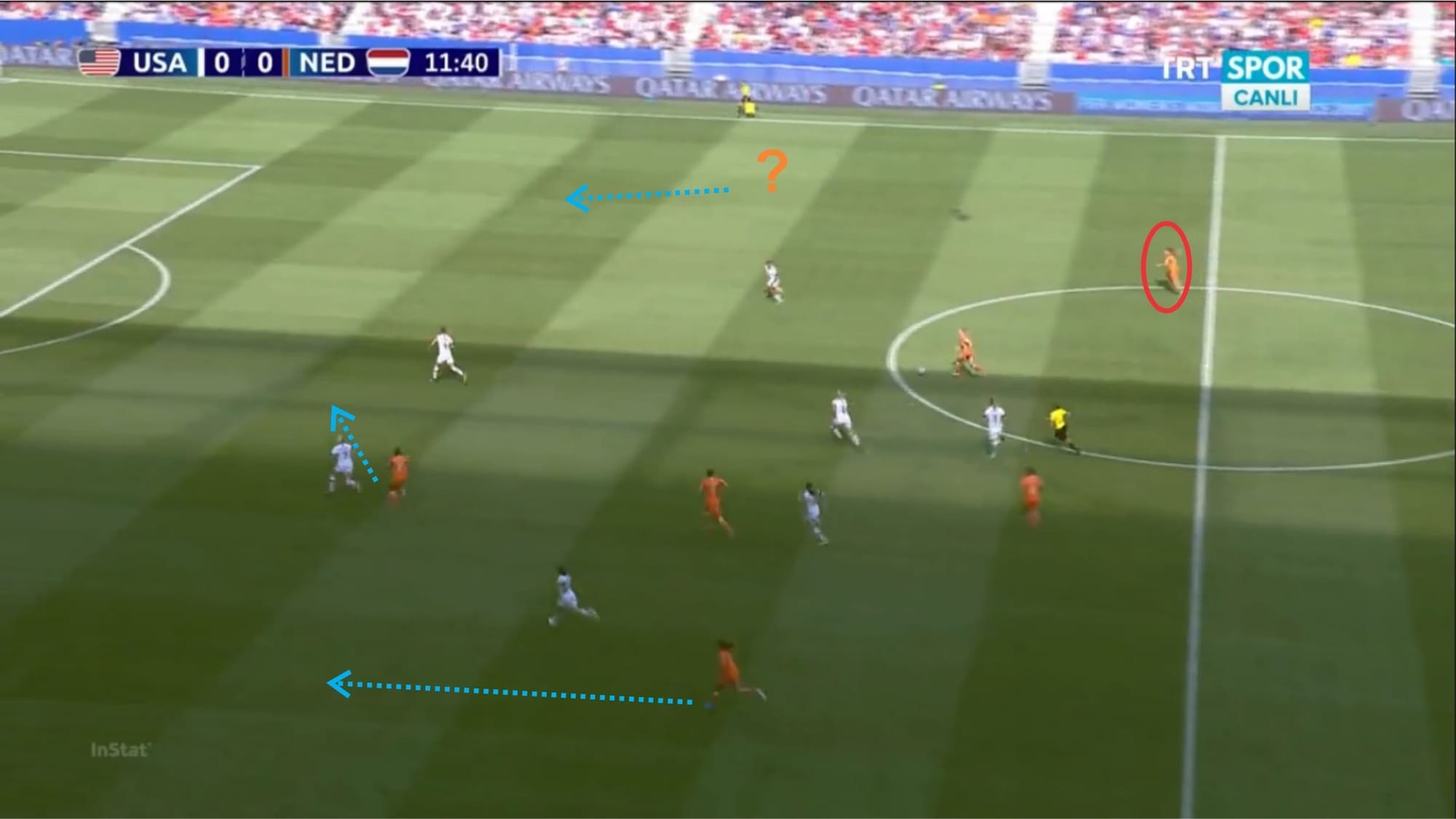
This is another picture that showed the Netherlands’ flaw in counter-attacks. De Oranje Leeuwinnen had just won possession on the left side of the pitch, the defender then gave the ball to Groenen on the middle. Now we can see here that Beerensteyn positioned herself in the middle again rather than roaming wide. She’s being marked tightly by Dahlkemper and a through ball towards her seemed unlikely to be successful. Meanwhile, on the left-hand side, Martens was still trying to get into her designated spot, but still, she’s late and Groenen couldn’t afford to wait up for far too long due to the pressure she’s going to get. Right-winger van de Donk was even later, but at least she was free of any pressure, although, of course, that’s not the point.
The right flank could be exploited if there’s a player there to receive the ball and attack. But looking back at the picture, you can certainly see that the Netherlands failed to launch their quick counter again in this situation.
Exploiting the flanks have been the Netherlands’ strong point throughout the competition. Boasting the likes of Martens, van de Sanden, and Beerensteyn – they were feared for their frightening attacks from wider areas. It is very, very unfortunate not to see this happening against the USA. The defenders of the USA have surely done their job very well, but the Netherlands could have made them work harder.
No mercy in the second half
The visible change that could be seen since the start of the second half was Wiegman’s side putting more effort to press the USA. They started blocking high, overloading the flanks, trying to isolate the ball-carrier. The game looked a bit more balanced in this half with both the USA and the Netherlands having their fair share of possession. However, the Netherlands’ attacks never seemed to produce anything. Far, far different than the USA, who eventually got the fruits of their hard work in the midst of the second half.
Heath delivered a cross into the box but it was deflected by Spitse. Van der Gragt and Morgan both chased the ball and contested for it. The former tried to clear the ball, but failed, hitting the latter with her foot. The referee was hesitant to give the penalty at first, but a further review from VAR showed that van der Gragt made no contact at all with the ball prior to her foot hitting Morgan. The referee then awarded a penalty. Rapinoe stepped up and coolly slid the ball to the bottom right corner, past the unmoved van Veenendaal. The stadium roared from the combination of the screams of joy from the American fans and the yells of frustration from the Dutch spectators.
The Netherlands immediately turned to ultra-attacking mode after that goal. They wanted to get an equaliser as soon as possible. However, still, none of their attacking endeavours worked out. All of them were repelled by the solid and very organized USA defence. In fact, USA were the ones who became a dangerous threat to their opposition as they tried to rely on quick breaks after winning the ball.
Indeed they eventually scored their second merely eight minutes after the first one. Van de Donk dribbled the ball forward in the middle third, but Dunn managed to win the ball back impressively via a sliding tackle. The left-back then gave the ball to Mewis who in turn passed it to Lavelle. The latter brought the ball forward from the middle third to the edge of the box, while Morgan tried to open the space and drag Dekker out of her way. Lavelle managed to drive van der Gragt the other way with a feint, before moving onto her favoured left foot and struck the ball into the bottom right corner of the net, out of the reach of star goalkeeper van Veenendaal.
Wiegman then decided to bring in van de Sanden to the game, replacing centre-back Dekker. Along with this substitution, they seemed to also change into a three-player defence system, forming a 3-4-3 (or 3-3-1-3) shape.
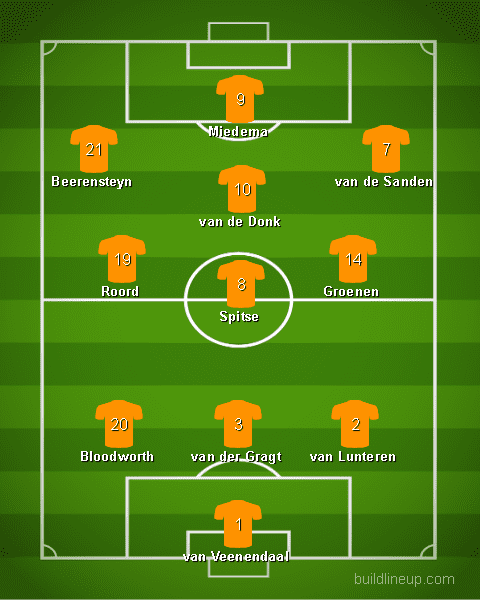
In these desperate times, the Netherlands seemed to throw six players forward. The USA, on the other hand, countered their tactics by switching into a five-player defence system, forming a 5-4-1 in defence than quickly switching to a 5-2-3 when breaking forward.
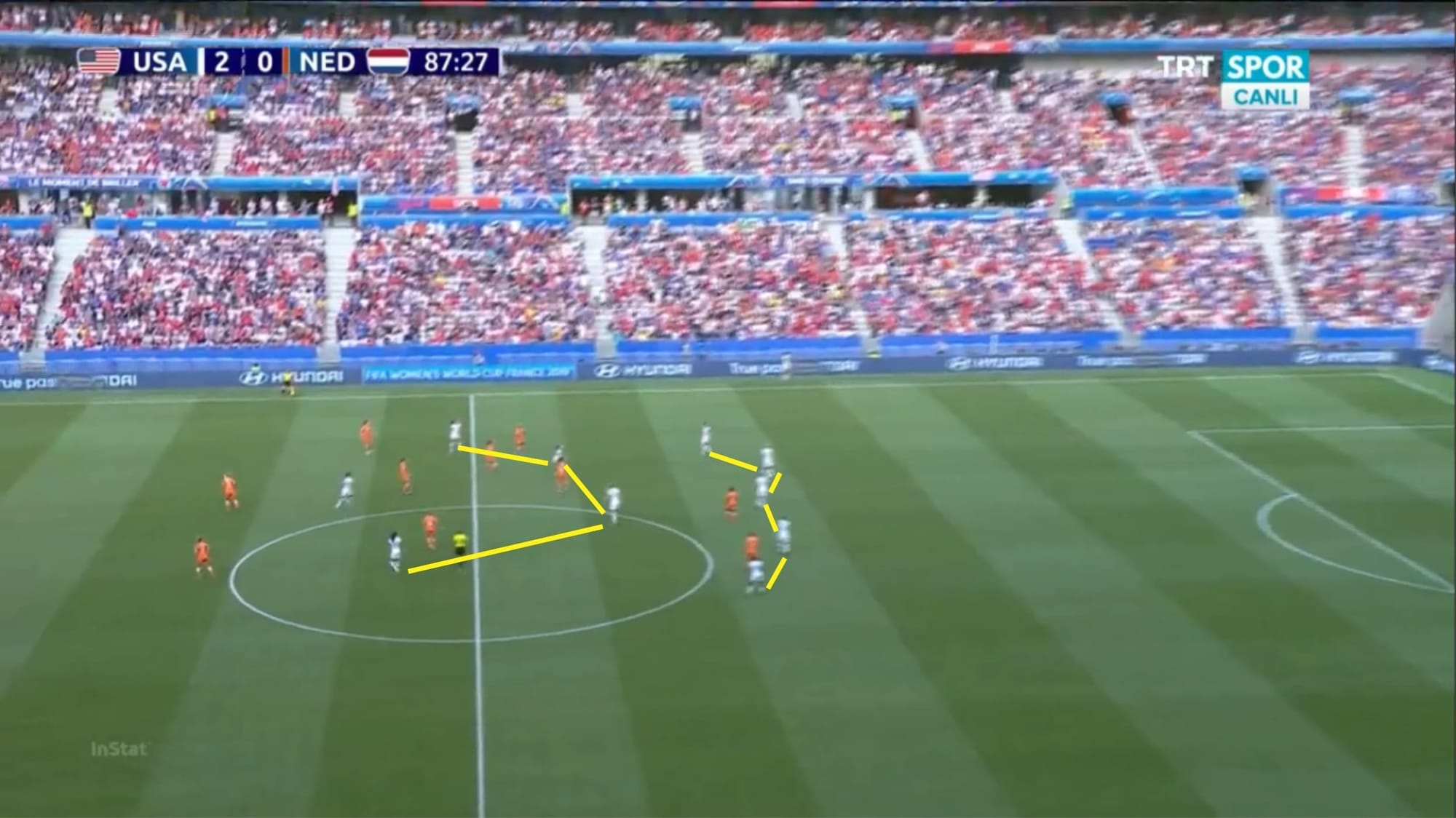
Again, the USA’s tactics proved to work very well against the Netherlands. Despite being outnumbered at the back, the USA defended very compactly, compressing space in the middle and defending in numbers inside the box. Their 5-2-3 shape also meant that they’ll be superior in numbers when on the counter with five players on the front foot while the Netherlands would only have four defending the counter-attack.
The USA almost scored another goal late in the second half despite already leading 2-0. There seemed to be no mercy at all from the USWNT.
Conclusion
The Netherlands may have suffered a loss in this game, but they shouldn’t be disheartened. They have made every Dutch fan proud even without winning. They have broken their previous record and set a new one as they entered the final and finished as runners-up. Who knows what might happen in the next edition of the FIFA Women’s World Cup?
For the USA, this is the moment that they’ve been waiting for. Criticisms and controversies might have followed them along their journey to the end of the competition, but their hard work and sacrifice were ultimately worth it. They’ve been crowned as the world champions yet another time, proving their dominance in women’s football.
With that said, I think it doesn’t matter whoever won the final of the 2019 FIFA Women’s World Cup. Both teams are the winners. In fact, every team that has participated in the competition are winners. They have successfully promoted and elevated women’s football to another level – even breaking the harsh opinions of those who belittled the importance and the relevance of women’s football. Lots of records have been broken in this year’s Women’s World Cup, but it doesn’t stop there. There will surely be more to come.
If you love tactical analysis, then you’ll love the digital magazines from totalfootballanalysis.com – a guaranteed 100+ pages of pure tactical analysis covering topics from the Premier League, Serie A, La Liga, Bundesliga and many, many more. Buy your copy of the June issue for just ₤4.99 here, or even better sign up for a ₤50 annual membership (12 monthly issues plus the annual review) right here.

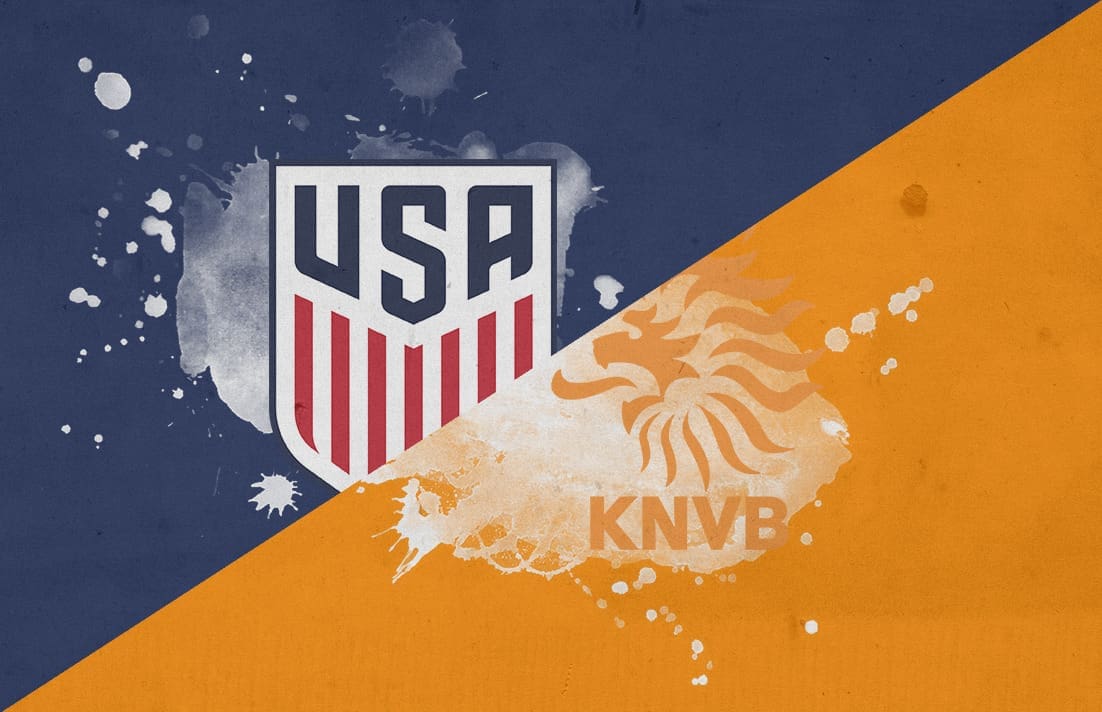



Comments